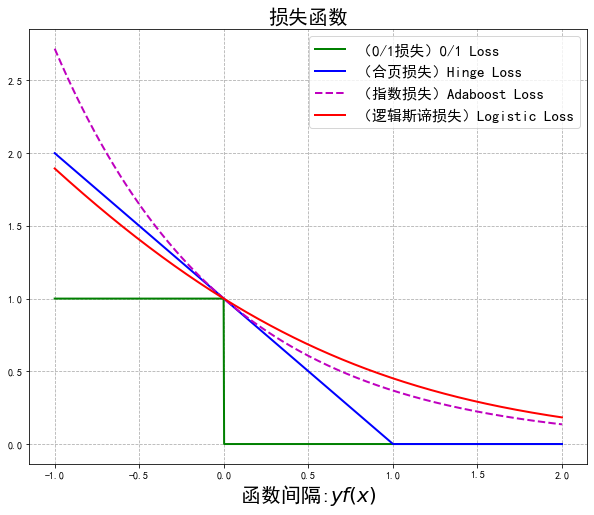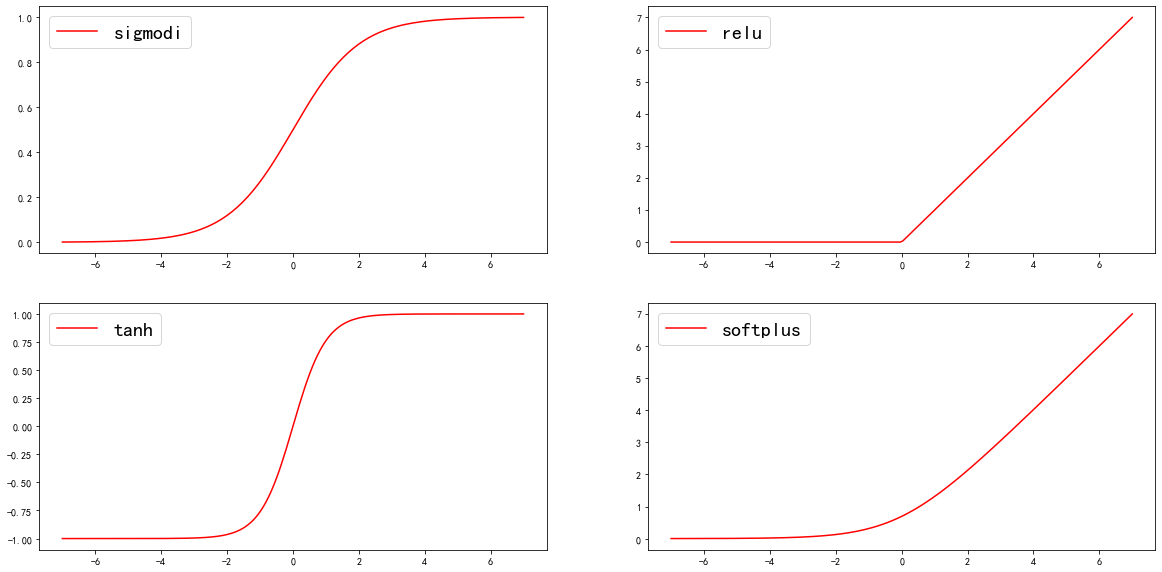import numpy as np import math import matplotlib.pyplot as plt plt.rcParams[‘font.sans-serif‘] = [‘SimHei‘] plt.rcParams[‘axes.unicode_minus‘] = False plt.figure(figsize=(10,8)) x = np.linspace(start=-1, stop=2, num=1001, dtype=np.float) logi = np.log(1 + np.exp(-x)) / math.log(2) boost = np.exp(-x) y_01 = x < 0 y_hinge = 1.0 - x y_hinge[y_hinge < 0] = 0 plt.plot(x, y_01, ‘g-‘, mec=‘k‘, label=‘(0/1损失)0/1 Loss‘, lw=2) plt.plot(x, y_hinge, ‘b-‘, mec=‘k‘, label=‘(合页损失)Hinge Loss‘, lw=2) plt.plot(x, boost, ‘m--‘, mec=‘k‘, label=‘(指数损失)Adaboost Loss‘, lw=2) plt.plot(x, logi, ‘r-‘, mec=‘k‘, label=‘(逻辑斯谛损失)Logistic Loss‘, lw=2) plt.grid(True, ls=‘--‘) plt.legend(loc=‘upper right‘,fontsize=15) plt.xlabel(‘函数间隔:$yf(x)$‘,fontsize=20) plt.title(‘损失函数‘,fontsize=20) plt.show()

import numpy as np import matplotlib.pyplot as plt #创建输入数据 x = np.linspace(-7,7,180) #激活函数的原始实现 def sigmoid(inputs): y = [1/float(1+np.exp(-x)) for x in inputs] return y def relu(inputs): y = [x*(x>0) for x in inputs] return y def tanh(inputs): y = [(np.exp(x)-np.exp(-x))/float(np.exp(x)+np.exp(-x)) for x in inputs] return y def softplus(inputs): y = [np.log(1+np.exp(x)) for x in inputs] return y y_sigmoid = sigmoid(x) y_relu = relu(x) y_tanh = tanh(x) y_softplus = softplus(x) fig = plt.figure(figsize=(20,10)) #创建各个图像 plt.subplot(221) plt.plot(x,y_sigmoid,c=‘r‘,label=‘sigmodi‘) plt.legend(loc=‘best‘,fontsize=20) plt.subplot(222) plt.plot(x,y_relu,c=‘r‘,label=‘relu‘) plt.legend(loc=‘best‘,fontsize=20) plt.subplot(223) plt.plot(x,y_tanh,c=‘r‘,label=‘tanh‘) plt.legend(loc=‘best‘,fontsize=20) plt.subplot(224) plt.plot(x,y_softplus,c=‘r‘,label=‘softplus‘) plt.legend(loc=‘best‘,fontsize=20) plt.show()

原文:https://www.cnblogs.com/yukizzc/p/12720610.html